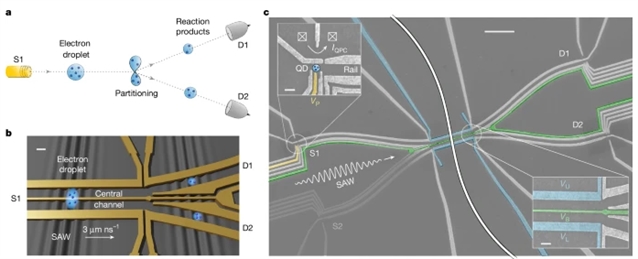
近日,法国阿尔卑斯格勒诺布尔大学Sellier, Hermann团队揭示了少电子液滴中库仑液相的证据。这一研究成果于2025年6月25日发表在《自然》杂志上。
从一个足够大的基本成分群体内的相互作用中出现普遍的集体行为是一个基本的科学概念。在物理学中,波动微观可观测值的相关性可以提供有关物质集体状态的关键信息,例如重离子碰撞中的去精细夸克-胶子等离子体或膨胀的量子简并气体。通过散粒噪声测量,介观对撞机提供了确凿的证据,证明了分数电荷、悬浮子和任意子统计等奇异电子激发的性质。然而,在微观层面上,弥合两个粒子碰撞之间的差距以及随着相互作用粒子数量的增加而出现的集体性仍然是一项具有挑战性的任务。
研究组展示了在半导体器件中,由通过Y结的移动势阱驱动的包含多达N=5个电子的电子液滴分配中的所有体关联。使用高阶多元累积量和朝向热力学极限的有限尺寸标度分析分区数据,揭示了强相关库仑液体的独特指纹。这些指纹与一个普遍的极限非常吻合,在这个极限下,液滴的划分是由一个单一的集体变量预测的。该电子液滴散射实验说明了如何通过少数基本成分的相互作用产生协调行为。研究其他物理平台(如冷原子模拟器或任意电子激发集合)中的类似特征可能有助于识别奇异相的出现,更广泛地说,有助于深化对物质工程的理解。
附:英文原文
Title: Evidence of Coulomb liquid phase in few-electron droplets
Author: Shaju, Jashwanth, Pavlovska, Elina, Suba, Ralfs, Wang, Junliang, Ouacel, Seddik, Vasselon, Thomas, Aluffi, Matteo, Mazzella, Lucas, Geffroy, Clment, Ludwig, Arne, Wieck, Andreas D., Urdampilleta, Matias, Buerle, Christopher, Kashcheyevs, Vyacheslavs, Sellier, Hermann
Issue&Volume: 2025-06-25
Abstract: Emergence of universal collective behaviour from interactions within a sufficiently large group of elementary constituents is a fundamental scientific concept1. In physics, correlations in fluctuating microscopic observables can provide key information about collective states of matter, such as deconfined quark–gluon plasma in heavy-ion collisions2 or expanding quantum degenerate gases3,4. Mesoscopic colliders, through shot-noise measurements, have provided smoking-gun evidence on the nature of exotic electronic excitations such as fractional charges5,6, levitons7 and anyon statistics8. Yet, bridging the gap between two-particle collisions and the emergence of collectivity9 as the number of interacting particles increases10 remains a challenging task at the microscopic level. Here we demonstrate all-body correlations in the partitioning of electron droplets containing up to N=5 electrons, driven by a moving potential well through a Y-junction in a semiconductor device. Analysing the partitioning data using high-order multivariate cumulants and finite-size scaling towards the thermodynamic limit reveals distinctive fingerprints of a strongly correlated Coulomb liquid. These fingerprints agree well with a universal limit at which the partitioning of a droplet is predicted by a single collective variable. Our electron-droplet scattering experiments illustrate how coordinated behaviour emerges through interactions of only a few elementary constituents. Studying similar signatures in other physical platforms such as cold-atom simulators4,11 or collections of anyonic excitations8,12 may help identify emergence of exotic phases and, more broadly, advance understanding of matter engineering.
DOI: 10.1038/s41586-025-09139-z
Source: https://www.nature.com/articles/s41586-025-09139-z
Nature:《自然》,创刊于1869年。隶属于施普林格·自然出版集团,最新IF:69.504
官方网址:http://www.nature.com/
投稿链接:http://www.nature.com/authors/submit_manuscript.html
